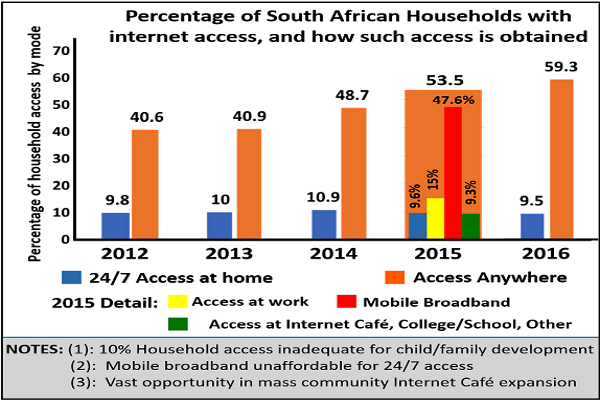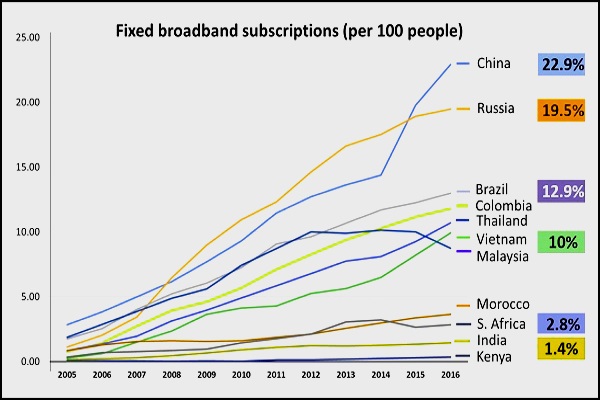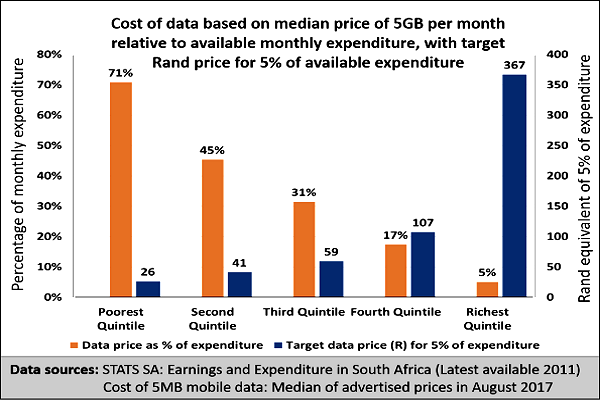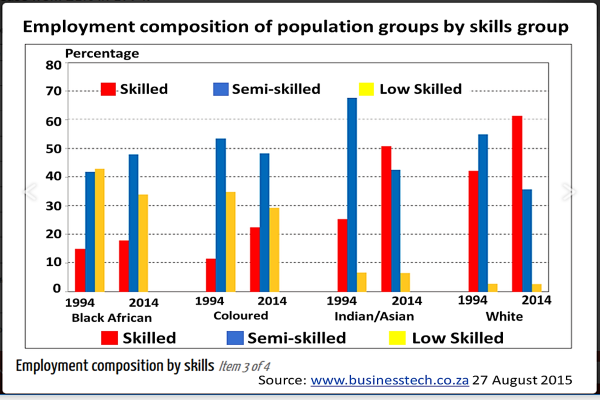A review of ICT in South Africa
- 1860: First telegraph between Cape Town and Simonstown;
- 1878: First telephone lines in South Africa, just 2 years after Alexandra Graham Bell filed his telephony patent;
- 1879: First undersea cable between South Africa and Europe, followed by a near hiatus lasting 89 years before the launch of SAT-1 undersea cable linking South Africa to Europe, and another 41 years before the launch of the high capacity fibre optic submarine cables of Seacom and EASsy launched the current era of high capacity international data connections;
- 1898: First RFQ for a wireless telegraph system intended for use in the Anglo-Boer wars of late 19th century;
- 1991: The launch of the Internet in South Africa - the first IP packets were sent between the computing centre at Rhodes University in Grahamstown and the home of Randy Bush, an early Internet pioneer based in Portland, United States. The statistics presented in these and pages to come show that South Africa struggled to spread the value of the Internet to all its citizens, after this highly commendable early start;
- 1994 launched the era of ubiquitous mobile telephony in South Africa, and the current round of discussions concerning the launch of the latest ICT products and services, the 5G and IoT world of the 4IR.
The statistical representations that follow illustrates the immense challenges that South Africa faces in ensuring that the majority of the nation's children and youth have access to the technologies that will equip them for the uncertain 4IR future. The young residents of economically marginalized households will remain marginalized if we do not address the very low levels of Internet access at home as illustrated by the first chart. Similarly, connecting such economically households will be a major challenge given the comparatively slow growth of the nation's fixed broadband infrastructure as illustrated in the second chart, nor will such connectivity be effective if we do not address the affordability challenge illustrated in the last chart. These statistics represent the starting point for this SAKAN initiative – they will be refined, with errors corrected where they exist and as new statistical data becomes available, and as the process itself unfolds.
- The first chart, the modes and levels of household access to the Internet, shows that South Africa’s always on fixed Internet access at home penetration has been stagnant at about 10% over the 5-year period for which statistics are available. The importance of having 24/7 Internet access at home, and the terminal equipment needed to use it productively, cannot be understated. Whole families and residents that share the household need such access for entertainment with learning, vital survivalist and especially personal and community safety and security communications. Early childhood development (ECD) becomes possible 24/7 at home with such facilities, a vital requirement for survival in the unfolding 4IR. The 24/7 household access modes must be technologically neutral, but they must be reliable, and of adequate quality. The chart shows a relatively high level of mobile broadband access, this is of course most welcome, and is a valid and convenient connectivity method, but it must be affordable and always available to lift the household access levels from 10% towards the desired target of 100%;
- Providing fixed Internet connectivity to all households in a society afflicted by extreme levels of income inequalities and the resulting high levels of poverty and unemployment, is a near-impossible task while the society remains at a low or even middle level of economic development. The second access chart, illustrating the growth of fixed broadband penetration over the 10-year period 2005 to 2016, provides many insights into how different nations approach the challenge of information and knowledge delivery via ICT. Developing nations with similar economic and environmental constraints like Colombia, Thailand and Vietnam, are clearly more focused on national inclusive development via ICT than South Africa is.
- It is important to note that the definition of “fixed broadband” used in deriving the second chart is technologically neutral – fixed physical and wireless infrastructure are equally effective at bridging the nation’s digital divides. The modern 4G and emerging 5G mobile technologies enable simple methods of delivering fixed services to premises without changing the architectural and engineering strategies used to deliver mobile services. This opens up numerous innovative ways of ensuring mass access to broadband in poor communities – change the definition of a single “subscription” to include a single mass access public space in which a large number of citizens can share the available broadband at prices that they can afford, and in places within reach of their families, especially their children. This conceptual change of individual connectivity to massively shared broadband connectivity is what lies at the heart of the SAKAN concept;
- The third chart is perhaps the most disturbing: the deep inequality and poverty levels prevalent in South Africa today makes it almost impossible to service the information and knowledge needs of the poor under the current policy and regulatory instruments: full uncapped broadband access must be provided at approximately ZAR26 per month to the 15 million citizens that reside within the lowest income quintile. The affordability levels used in this analysis have been derived from easily available earnings statistics published by STATS SA and others, and a spot check of local broadband pricing conducted through a simple web search. The selected broadband consumption level of 5GB per month has been arbitrarily chosen for comparison purposes, on the basis that the quantity of information and knowledge needed by individuals and communities cannot or must not be static – an enterprising learner or potential entrepreneur may need to download several GB of high resolution educational videos over a few late nights (when less sharing gives high speeds), while a neighbour’s needs may be much lower – news updates and email communications. The target usage must be unlimited broadband access by individuals, even in public broadband facilities as proposed by SAKAN;
- The last chart presents a highly complex compendium of challenges, which range from the highly sensitive race factor, through the challenging national unemployment levels, to the even more challenging national skills development needs. It is already clear that the advent of automation and the use Artificial Intelligence (AI) IoT connected machines will have a devastating impact on all levels of traditional work, especially the low-skilled and semi-skilled populations portrayed in the chart. Even high skill requiring jobs will be impacted, as AI automatons take over high level skills such as computer programming and ICT content management. This chart, in a nutshell, suggests that even our traditional educational systems, already in need of significant development, will need to be fundamentally revised to meet the needs of the irreversible and highly disruptive 4IR. This chart needs deep introspection, however, the multifaceted challenges cannot wait for such deep introspection. Immediate action is required – the SAKAN initiative is one such action-oriented intervention, subject as it is to continuous refinement in a virtuous circle mode as strongly recommended by South Africa’s National Development Plan.
While the SAKAN target is clearly the economically marginalized population of South Africa, evidence from more progressive developing nations like China, Japan and South Korea show that the SA-LAN concept has migrated to serve the needs of even the wealthy communities who already have full connectivity at home: The "community" spirit of the LAN-Houses fosters such social gatherings, made even more relevant by the highly competitive and potentially lucrative eSport movement. SAKAN ends this section with yet another reminder of what can be achieved, a very small visual survey of South Africa's peer developing nations they continue to use the concept proposed by SAKAN.








